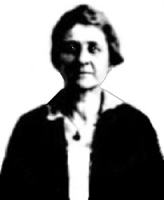
|
The Society of Folk Dance Historians (SFDH)
Can We Ever Know IFD Origins?
[
Home |
About |
Encyclopedia | CLICK AN IMAGE TO ENLARGE |

|
BACKGROUND
In 1999, I published in a promotional letter the statement that recreational International Folk Dancing (IFD) originated in 1894 in Chicago with Mary Wood Hinman. I received this e-mail message from a person who had been a member of the Society in 1998, and my reply follows.
Dear Ron Houston,
 I received your letter and additional forms. I may or may not respond because I am not much involved in running dances anymore and currently I am very busy. Maybe some day . . .
I received your letter and additional forms. I may or may not respond because I am not much involved in running dances anymore and currently I am very busy. Maybe some day . . .
But I have to respond to your first sentence. "International folk dancing started in 1894 with Mary Wood Hinman in Chicago." (Is this in the United States?)
Radcliffe College in Cambridge, Massachusetts (founded 1879) has issued annual reports from 1880 on, and each issue until about 1940 would have a report about Physical Education. Issues of the report from 1908 on stated that there was a demonstration of Gymnastics and Dancing. Being a demonstration, I would think that this would be some form of folk dancing. In 1925 and in 1933, it stated specifically folk dancing and clogging. Reports in later years also mention folk dancing and performances.
Logically, Radcliffe would have had folk dancing as part of their physical education program in years prior to 1908 when Demonstrations began. I found no evidence of when they began and could not say whether it was before or after 1894.
I believe that it is presumptuous to say that international folk dancing started in 1894 . . . in Chicago. How could anyone make this claim without searching all records everywhere? Anyway, I believe such a search would be futile. Even if no records are found, the question is not answered. Records are lost and records are not kept.
Folk dancing at Massachusetts Institute of Technology (MIT), in which I was active for many years, began in 1950. I could find no records at all of its early years, and even the year 1950 is from someone's memory.
Frankly, I cannot take seriously any statement claiming when and where folk dancing started.
Sincerely,
[Name deleted to protect the privacy of the sender.]
Thank you, [name deleted], for the lead to a potential source of information about the early days of our folk dancing. How does one access such reports? Although Modern Dance occupied a similar niche at the same time, the "Gymnastics and Dancing" could very well have included what we call folk dance, for reasons I will explain below. It was "hot" then. There are many such avenues to pursue, and I have not explored them all and likely never will. I appreciate your help.
You are absolutely right to question the statement:
► "International folk dancing started in 1894 with Mary Wood Hinman in Chicago."
It is nothing more than a convenient shorthand to answer a common question: "Ron, when did folk dancing start?"
A more complete answer:
"My 30-year search of the literature in folk dancing, sociology, gymnastics, children's games, ethnic studies, ethnomusicology, demography, folklore, dance, and related fields has failed to produce any document or reference to a document demonstrating or even implying the gathering of people for the recreational purpose of performance of dances from a deliberately chosen variety of foreign cultures and leading to the movement we now call recreational international folk dancing, prior to Mary Wood Hinman's Chicago groups and publications of 1894."
But who, aside from true scholars, wants to hear all that? So I use the shorthand and cherish those who question it.
Yes, this is for the United States, but every country that now does recreational international folk dancing learned it from Americans: Nat Brown in England, the Keithleys in Japan, and Rickey Holden in virtually every other country.
Of course people folk danced before 1894. Tsarist Russia had a repertoire of recreational ballroom dances based on music and motifs from other countries. But that movement died with the tsars, even though we got some of the dances. Other examples are even weaker.
Beyond the utter lack of evidence in places it should be, we also have a logical basis for the statement. A number of sociological forces (immigration, urbanization, affluence, recognition of human rights) converged in late 19th century America to create a need for recreational international folk dancing and its alter-ego, folk dance exhibitions. (I published all this in the 1996 Folk Dance Problem Solver and won't bore you with the details. Several copies reside in your area, though, so if you are visiting folk dance friends, ask to read it.)
Finally, the evolution is a continuous and logically sequential one from Hinman through Gulick, Burchenal, and a host of subsequent promoters. Yes, there might be a precursor, just as there might have been a race of supermen in North Europe during a previous Ice Age or a great civilization of proto-humans a million years ago, but just as with evolution, the history of folk dancing demonstrates absolutely no evidence of such an occurrence. At some point, you have to say "for all practical purposes, this looks like the beginning."
Please note, [name deleted], that I have been wrong before. For many years, I thought Gulick was the first. I was delighted to discover that I was wrong, and I will be delighted to discover that I am wrong now.
Yes, records are lost or simply not kept. Folk dancing, however, has a fairly well-documented and continuous history and occurred among people who do keep records. Recall that the modern library era began with Melvil Dewey in Chicago in 1876, and historically many of the same social strata participate in folk dancing: librarians, archivists, educators, and other educated, middle class people. If folk dancing occurred prior to 1894, its effects are pretty well hidden.
Please continue to question my work and to pass on leads.
–Ron
DOCUMENTS
- Chronology of International Folk Dancing, an article.
- Ron Houston, an article.
This page © 2018 by Ron Houston.
Please do not copy any part of this page without including this copyright notice.
Please do not copy small portions out of context.
Please do not copy large portions without permission from Ron Houston.